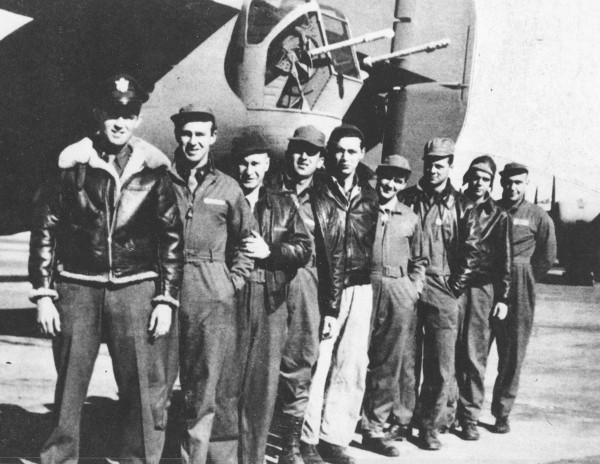
The American bomber Lady Be Good left North Africa for a bombing run over Italy in 1943. It wasn’t seen again until 15 years later, when explorers discovered its broken remains deep in the Libyan desert. In this episode of the Futility Closet podcast we’ll review the strange history of the lost aircraft and trace the desperate last days of its nine crewmen.
We’ll also climb some twisted family trees and puzzle over the Greek philosopher Thales’ struggles with a recalcitrant mule.
Sources for our segment on the Lady Be Good:
Mario Martinez, Lady’s Men, 1995.
Dennis E. McClendon, The Lady Be Good: Mystery Bomber of World War II, 1962.
Above: The Lady Be Good as she was discovered 440 miles southeast of Benghazi, in remarkably good condition for a plane that had landed itself with one working engine and then lain in the desert for 15 years. The tires on the nose wheel and one of the main landing wheels were undamaged and fully inflated.

The crew: William J. Hatton, pilot; Robert F. Toner, co-pilot; D.P. Hays, navigator; John S. Woravka, bombardier; Harold J. Ripslinger, flight engineer; Robert E. LaMotte, radio operator; Guy E. Shelley Jr., waist gunner; Vernon L. Moore, waist gunner; and S.E. Adams, tail gunner. Hatton, the leader, was probably the first to die. Five months before his posting to Libya, he had written to his mother, “There are about four places they can send me. Arizona, Idaho, and Spokane or Tacoma, Washington. I am sitting here waiting to see which one it is. I hope it isn’t Arizona because I am tired of sand.”
Listener mail:
Our Dec. 21 post “A Man His Own Grandfather,” reprinting an 1868 item about a man whose stepdaughter marries his father, follows a similar post from 2009, “Proof That a Man Can Be His Own Grandfather,” which includes a diagram.
The song “I’m My Own Grandpa” was released by Lonzo & Oscar in 1947. This cover version includes a diagram that explains the relationships:
Thanks to reader David Wright for sending a link to an article in Geneaology Magazine that traces the history of the idea, and to reader Mark Williamson for sharing his own convoluted family tree:
My own mother was an only child, whose father died when she was 9 years old. Her mother then remarried an older man who had several children (and they went on to have several more together). My maternal grandmother’s younger brother was in the military, and when home on leave fell in love with one of my mother’s stepsisters, and they got married and had children of their own. So my grandmother’s brother was my great-uncle, and his wife was my great-aunt, and their children were my second cousins, but he was also my uncle because he was married to my aunt (my mother’s stepsister) and their children were my first cousins. And their father was also their great-uncle, since he was their grandmother’s brother, and therefore their mother was their great-aunt since she was married to their great-uncle. And since they were their great-aunt’s children, that made them their own second cousins.
The first of this week’s two lateral thinking puzzles was inspired by a chance encounter with N.L. Mackenzie’s article “The Nastiness of Mathematicians” in the Pi Mu Epsilon Journal (vol. 9, no. 10, Spring 1994) while toiling at NC State this week. It’s not certain that the story actually befell Thales; the same story is told in Aesop’s fable “The Salt Merchant and His Ass.”
The second puzzle is drawn from Eliot Hearst and John Knott’s excellent 2009 book Blindfold Chess and from Miguel Najdorf’s New York Times obituary (warning: this spoils the puzzle).
Hearst and Knott’s website explains how Najdorf’s longstanding record of 45 blindfold games played simultaneously was broken in 2011 by Marc Lang of Günzburg, Germany. Lang played 46 games and scored +25, =19, -2, as against Najdorf’s astounding +39, =4, -2 in São Paulo in 1947.
You can listen using the player above, download this episode directly, or subscribe on iTunes or via the RSS feed at http://feedpress.me/futilitycloset.
Please consider becoming a patron of Futility Closet — on our Patreon page you can pledge any amount per episode, and all contributions are greatly appreciated. You can change or cancel your pledge at any time, and we’ve set up some rewards to help thank you for your support.
You can also make a one-time donation via the Donate button in the sidebar of the Futility Closet website.
Many thanks to Doug Ross for the music in this episode.
If you have any questions or comments you can reach us at podcast@futilitycloset.com. Thanks for listening!
